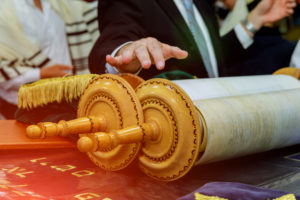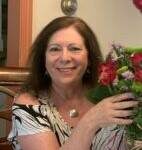
By Rabbi David Ackerman
Parshat Sh’mini
“Look both ways before you cross!” That’s guidance we’ve all heard, likely drilled into us as children. The deep story of Pesach, I suggest, is a tale of looking both ways before crossing.
Pesach’s last days commemorate the crossing of the Red/Reed Sea, in many ways the climactic moment of the Exodus. The liturgy of the seventh (biblically, the last) day of Pesach centers on the reading of shirat haYam — the triumphal “song of the sea” after they crossed through, completing the first stage of their journey from slavery to freedom. And the medieval prayer book added dozens of piyyutim — liturgical poems that became part of the worship service in many communities — that riffed on the themes and the very words of the Bible’s original song.
One piyyut — a 12th-century composition written by Yekutiel bar Yosef — utilizes the Torah’s words to lay out the look both ways idea with great power. He calls the crossing of the sea Pesach Mitzrai — the actual historical moment of redemption recounted
in the Bible.
The companion to the Torah’s Exodus is something that our poet calls Pesach le-Atid — the anticipated great redemption of the future. As the note in Siddur Lev Shalem (where a portion of the piyyut appears on p. 360) puts it: “throughout the generations Pesach was not only a commemoration of a historical event but a signal of a future redeemed world.” In other words, look both ways before you cross.
Rabbi Yitz Greenberg beautifully captures Pesach’s look both ways dynamic: “What it did was set up an alternative conception of life. Were it not for the Exodus, those humans would have reconciled themselves to the evils that exist in the world. The Exodus reestablishes the dream of perfection and thereby creates the tension that must exist until reality is redeemed. This orienting event has not yet become our permanent reality … But it points the way to the end goal toward which all life and history must go. Every generation comes to grips with its own reality: it is something to be lived in, and also to be challenged and overcome.” (The Jewish Way, p. 36, emphasis added)
This Shabbat we encounter Parshat Sh’mini, often read on the Shabbat immediately after Pesach. In less dramatic, but more quotidian and arguably more realistic fashion, Sh’mini too presents to us the challenge and necessity of looking both ways before we cross. Professor Tamar Kamionkowski’s summary (taken from her beautiful and elegant Leviticus commentary on p. 75, emphasis added) of the passage I have in mind sets the stage.
“The final verses of Leviticus 10 describe an argument between Moses and Aaron. Although the text is somewhat elusive, it seems that Moses becomes angry because he notes that while the grain and well-being offerings were consumed by the priests, the meat of the purification offering had not been consumed as instructed in Leviticus 6:26. Moses rebukes Aaron’s sons and claims that YHVH would not accept the purification offering on behalf of the people. The specific content of Aaron’s response is difficult to understand, but it is clear that Aaron is claiming the authority to interpret the law and that Moses submits to Aaron’s authority regarding ritual law.”
What makes this a look both ways moment is that, according to the Talmud (Bavli Kiddushin 30a) the opening words of this passage — in Hebrew darosh darash (inquired emphatically or explored deeply) — are the middle words of the Torah! The ancients (lacking streaming and social media and the like) spent a lot of time with holy writings and knew the words inside and out. The Talmud tells us that one group of early sages were called sofrim — usually translated as “scribes” — because they counted (lispor) the words, verses, even letters of Scripture and tabulated them. Say the sofrim (on Leviticus 10:16): ”The midpoint of the Torah according to words; darosh from here, darash from here.”
A technical point perhaps, but consider what that phrase darosh darash really means. Something like “inquire deeply” or “explore intently” or “pursue meaning” or “interpret and interpret.” And following the directional guidance of the sofrim all of that is to be engaged by looking both ways, forward and back, or from more than one perspective, at the same time.
As one 16th-17th century commentator, R Shmuel Edels (Maharsha) expresses it: “Every word has meaning in the direction of purity and in the direction of impurity … the two are one … they are (the) two aspects of the Torah.”
The ancient rabbis surely knew something about the Roman god Janus, the god of doorways, thresholds and crossings, who was often depicted with two faces oriented in opposing directions. The rabbinic version of looking both ways belongs to us, regular people, and not just the gods.
While often elusive and unclear, we’re called upon to live in the tension created by looking back into our history and forward toward our future, simultaneously seeing the impurity that exists today and the purity that may yet come to be tomorrow.
Rabbi David Ackerman is the spiritual leader of Congregation Beth Am Israel in Penn Valley. The Board of Rabbis of Greater Philadelphia is proud to provide diverse perspectives on Torah commentary for the Jewish Exponent. The opinions expressed in this column are the author’s own and do not reflect the view of the Board of Rabbis.





